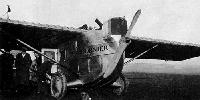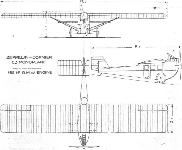
Варианты
- Dornier - Komet - 1921 - Германия
- Dornier - Do.B Merkur - 1925 - Германия
Dornier Do C Delphin I, II и III и Komet I и II
<...>
В 1921 году взлетел самолет Do C III Komet I, по сути, являвшийся сухопутным вариантом Delphin I, у которого корпус лодки заменили обычным фюзеляжем, и сохранивший много общего со своим прародителем. Машина имела высокий фюзеляж, неубирающееся шасси, подкосное оперение, крыло с постоянной хордой, подкрепленное подкосами. Двигатель был перемещен в носовую часть фюзеляжа. Сначала на самолете был установлен мотор BMW IIIa мощностью 185 л. с. (138 кВт), но из-за этого потолок машины оказался больше, чем допускалось условиями Версальских соглашений. По требованию Контрольной комиссии силовую установку заменили на BMW III мощностью 180 л.с. (134 кВт). Четыре пассажира размещались в закрытой кабине под крылом, а пилот сидел в открытой кабине сверху фюзеляжа, сразу за задней кромкой крыла. Сохранившиеся документы не позволяют судить о количестве построенных машин, но известно, что некоторые из них были впоследствии доработаны до стандарта Merkur. Известно несколько экземпляров Komet I, служивших сначала в авиакомпании "Deutsche Luft-Reederei", затем в "Deutsche Aero Lloyd" и, наконец, в "Deutsche Luft Hansa" (DLH), организованной в 1926 году.
Усовершенствованный вариант, Komet II, взлетевший 9 октября 1922 года, выпускался в больших количествах и служил на авиалиниях в Колумбии, Испании, Швейцарии и СССР, а также в Германии. Он имел удлиненный фюзеляж, вмещавший то же количество пассажиров, но экипаж состоял из двух человек. Самолет был оснащен двигателем BMW IV мощностью 250 л. с. (186 кВт).
Описание:
- Dornier Do C Delphin I, II и III и Komet I и II
- Dornier Do B Merkur, Do C Komet III, Do D и Do T
- Flight, March 1921
A NEW GERMAN ALL-METAL MACHINE
Фотографии
-
АэроХобби 1994-04 / Р.Мараев - Украинское акционерное общество воздушных сообщений "Укрвоздухпуть" /В небе Украины/ (1)
Самолет Dornier Komet I - конкурент для Junkers F-13
-
Flight 1923-07 / Flight
The Dornier "Komet," a medium-powered commercial limousine monoplane, mainly of metal construction.
-
Flight 1921-03 / Flight
THE ZEPPELIN DORNIER C3: Three-quarter front view.
-
Мировая Авиация 43
31 декабря 1922г.: Dornier Komet компании "Deutsche Luft-Reederei" стал первым немецким самолетом, приземлившимся после Первой мировой войны в Великобритании (на аэродроме Лимпн).
-
Aeroplane Monthly 1984-01 / J.Stroud - Wings of Peace
Регистрационный номер: CH-50 CH 50, a Dornier Komet I operated by Ad Astra Aero AG of Zurich. The windshield can be seen mounted on the wing leading edge. The aeroplane in the background is a Sablatnig P III.
Другие самолёты на фотографии: Sablatnig P.III - Германия - 1919
-
Aeroplane Monthly 1984-02 / Skywriters
Регистрационный номер: J7276 In his article on the Dornier Komet, John Stroud makes a passing reference to the Komet I tested in the UK as J7276. The enclosed photograph of it at Martlesham Heath during those trials may be of interest. The picture is dated September 12, 1924, but this is not necessarily the date that it was taken.
-
Flight 1921-03 / Flight
THE ZEPPELIN DORNIER C3: Front view.
-
Aeroplane Monthly 1984-01 / J.Stroud - Wings of Peace
Регистрационный номер: D-248 [2] Komet I D-248 Dusseldorf
-
Aeroplane Monthly 1984-01 / J.Stroud - Wings of Peace
Probably the prototype Dornier Komet, with aft-positioned cockpit. The raised instrument panel can be seen forward of and to the right of the cockpit.
-
Aeroplane Monthly 1984-01 / J.Stroud - Wings of Peace
Probably the prototype Komet II. It has a much smaller rudder than the prototype Komet I. The aileron balance surface can be seen in this view.
-
История Авиации 2003-02 / С.Корж - Коммерческая авиация /Ретроспектива/ (7)
Регистрационный номер: D-223 [2] "Комета II" "Дойче Люфт Рэдэрай" над берлинским аэропортом Темпельхольф. Борт В 223 стал первым самолетом, выполнившим посадку в Англии после окончания Первой Мировой войны.
-
Aeroplane Monthly 1989-03 / J.Stroud - Wings of Peace
Регистрационный номер: D-223 [2] The DLR Dornier Komet II D-223 at Rotterdam.
-
АэроХобби 1994-04 / Р.Мараев - Украинское акционерное общество воздушных сообщений "Укрвоздухпуть" /В небе Украины/ (1)
Регистрационный номер: RRUAA [3] Передача "Укрвоздухпути" самолета Komet-II "Донец-железнодорожник"
-
Авиация и Время 1995-01 / Р.Мараев, Л.Андерссон - Украинское акционерное общество воздушных сообщений "Укрвоздухпуть" /В небе Украины/ (2)
Регистрационный номер: RRUAA [3] Самолет Komet II "Донец-железнодорожник" на лыжном шасси
-
Авиация и Время 1995-02 / Р.Мараев, Л.Андерссон - Украинское акционерное общество воздушных сообщений "Укрвоздухпуть" /В небе Украины/ (3)
Регистрационный номер: RRUAA [3] Самолет Komet II RRUAA с мотором Rolls-Royce Falkon
-
АэроХобби 1994-04 / Р.Мараев - Украинское акционерное общество воздушных сообщений "Укрвоздухпуть" /В небе Украины/ (1)
Регистрационный номер: RR-16 Самолет Komet II (заводской номер 6/34) на Ходынском аэродроме в Москве
-
АэроХобби 1994-04 / Р.Мараев - Украинское акционерное общество воздушных сообщений "Укрвоздухпуть" /В небе Украины/ (1)
Регистрационный номер: RRUAC [2] Самолет Komet-II "Харьковский металлист"
-
Авиация и Время 1995-01 / Р.Мараев, Л.Андерссон - Украинское акционерное общество воздушных сообщений "Укрвоздухпуть" /В небе Украины/ (2)
Регистрационный номер: RRUAF [2] Самолет Komet II RRUAF в Елисаветграде, 1924г.
-
Авиация и Время 1995-05 / Р.Мараев, Л.Андерссон - Украинское акционерное общество воздушных сообщений "Укрвоздухпуть" /В небе Украины/ (4)
Регистрационный номер: RRUAC [2], RRUAF [2] "Кометы" на Харьковском аэродроме. В 1925г. самолеты УВП получили единую окраску: черный нос и светло-серые фюзеляж, оперение и плоскости
-
История Авиации 2003-02 / С.Корж - Коммерческая авиация /Ретроспектива/ (7)
Пассажирский самолет Dornier Komet III
-
Aeroplane Monthly 1984-01 / J.Stroud - Wings of Peace
This is almost certainly the Rolls-Royce Eagle IX powered prototype Dornier Komet III.
-
Aeroplane Monthly 1984-01 / J.Stroud - Wings of Peace
Регистрационный номер: D-580 [2] This Luft Hansa Komet III, D-580, was later named Panther and it is believed to have operated Luft Hansa’s first service, on April 6, 1926.
-
Air Enthusiast 1996-09 / P.Cooksley - Celestial Coaches
Регистрационный номер: D-580 [2] ‘Komet’ III ‘Panther’, later to become a ‘Merkur’, carries the route board ‘Berlin-Koln’ on the fuselage side under the wing. It is seen landing at what was later Berlin’s Tempelhof.
-
Aeroplane Monthly 1976-04 / H.Seabrook-Smith - Lufthansa 1926-76 (1)
Регистрационный номер: D-585 6 апреля 1936г.: "Luft-Hansa" начала выполнять регулярные рейсы на самолетах Dornier Komet III между Берлином, Галле, Эрфуртом, Штутгартом и Цюрихом.
Dornier Komet III D-585 Puma takes aboard passengers at Berlin-Tempelhof for the first scheduled Lufthansa flight on April 6, 1926. Note the uniformed "cabin-boy” holding the door open. -
Aeroplane Monthly 1984-01 / J.Stroud - Wings of Peace
Регистрационный номер: T-DODB DDL Danish Air Lines’ Komet III T-DODB had been Deutscher Aero Lloyd’s D-585 and was bought by DDL in 1925.
-
Aeroplane Monthly 1984-01 / J.Stroud - Wings of Peace
Регистрационный номер: J-BADA Kawasaki-built Komet III, J-BADA, with Lorraine engine and two-blade airscrew. This example incorporates some Merkur features and was operated by Tozai Teiki Kokukai on the Tokyo-Osaka route.
-
Air Enthusiast 1996-09 / P.Cooksley - Celestial Coaches
Регистрационный номер: J-BANA The ‘Komet’ III was licence-built in Japan in 1926. J-BANA owned by the Kawasaki Dockyard Company was operated by the Tozai Teiki Kokukai (TTK) airline, one of Japan’s first.
-
Aeroplane Monthly 1984-01 / J.Stroud - Wings of Peace
The passenger cabin of a Komet III. Behind the camera are two aft-facing seats. At least some of the windows could be slid open.
-
Flight 1921-05 / Flight
A NEW ZEPPELIN-DORNIER TWIN-ENGINED AEROPLANE: The keen competition between the Friedrichshafen and Staaken Zeppelin works appears to continue. In our issue of March 17 we published a photograph of the wind-tunnel model of a Staaken twin-engined monoplane. Above is seen the model of Herr Claude'Dornier's reply. This machine, it will be seen, has a fuselage practically identical to that of the single-engined land machine shown in our issue of March 31, 1921, and single-engined flying boat published on April 21, 1921. The new machine is characterised by a very low position of the engines, in fact one would imagine that they are placed too low. They are mounted on the ends of the usual Dornier wing roots growing out of the sides of the fuselage. From the outer lower corners of the engine nacelles bracing tubes run to the monoplane wing. Each of the landing wheels is enclosed in a streamline casing.
-
Flight 1921-05 / Flight
THE NEW ZEPPELIN-DORNIER TWIN-ENGINED MONOPLANE: This front view of the wind-tunnel model gives a good idea of the clean appearance of the machine.
-
Aeroplane Monthly 1984-01 / J.Stroud - Wings of Peace
Регистрационный номер: D-248 [2] KEITH WOODCOCK’S painting of Komet I D-248 Dusseldorf. This aircraft served with Deutsche Luft-Reederei and passed to Deutscher Aero Lloyd before becoming Luft Hansa’s Jaguar in 1926. The crane emblem, still used by Lufthansa, appears on the rudder.
-
Flight 1921-03 / Flight
Zeppelin-Dornier C3 monoplane
- Фотографии































